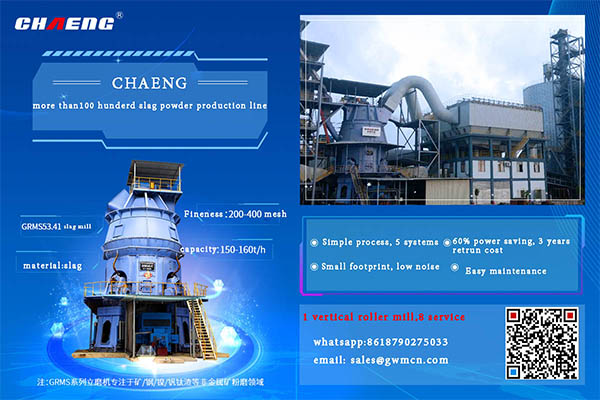
News Date:2019-01-11 13:48:15
The role of slag (slag products application) powder in concrete is reflected in the effects of fine aggregate effect and chemical activity. It is suitable for the preparation of high-strength, high-performance concrete and concrete projects with high requirements for bending strength such as roads and bridges; it has great applications in mass concrete engineering, underground concrete engineering, underwater concrete engineering and seawater concrete engineering. advantage.

In the vertical mill general contracting project, chaeng continues to innovate. In the production line of Mengneng Group's annual output of 1 million tons of slag powder, a number of technological features have been innovated to ensure the high-capacity, low-energy and smooth operation of the entire slag powder production line, mainly reflected in the following aspects:
1, wet and dry separation
That is, the slag vertical grinding and returning (outer circulation) and wet slag are separated into the grinding. The wet slag is fed into the vertical mill through a spiral reamer, and the returning material is fed to the vertical mill through the chute after the iron is removed.
Since the slag has a weak self-hydraulicity, the dry powder and the wet slag mixed by the vertical mill will have a weak hydration reaction and agglomerate, so the conventional mixed feeding scheme will cause the spiral reamer to be knotted, resulting in the reamer conveying ability. Drop even the reamer shaft breaks.
2. The external circulation adopts the buried scraper machine. The hoist is combined with the pipe separator.
The buried scraper hoist pipe separator is used to transport the vertical mill outer row. Since the returning material is always in the casing, the overflow of the returning dust can be avoided, and the surrounding environment of the vertical grinding can be greatly improved; and the conventional belt conveyor is suspended. The combination of the iron hoist, the belt conveyor and the air flow caused by the suspension of the iron remover will cause a large amount of dust at this position and a poor surrounding environment.
3, set the slag before the grinding into the steady flow bin (intermediate warehouse)
Set the slag steady flow bin and be closer to the vertical mill (located in the return frame). After the slag is metered by the belt scale under the steady flow bin, it falls to a short belt, and the belt transports the slag into the spiral cutter for grinding.
Setting the steady flow bin makes the vertical mill feed more uniform and the vertical mill runs more stable.
4. The efflux material that has been stopped grinding is re-entered into the vertical mill through the external discharge bin.
When the vertical mill stops grinding, the outer discharge material is discharged into the outer discharge bin on the return frame through the slide pipe, and the design quantity of the outer discharge bin is called. After the grinding is started again, the vertical mill grinding powder is fed again by the metering and weighing.
5. Dust collector is arranged on the chute conveying gallery
A dust collector is arranged on the chute corridor between the powder collecting device and the finished hoist, so that the chute and the finished hoist are always operated under a negative pressure state, so as to avoid the dust from being escaped due to the tight sealing of the casing.
6. Use two gate valves to replace the three-way dosing valve with high failure rate
7, slag bulk material recycling cycle
The large piece of material under the rotary sieve screen enters the crusher and is broken. The crushed fine particles are transported together with the qualified fine materials to the intermediate warehouse through the belt conveyor and then milled to achieve 100% utilization of the slag after the loader feeds.
8, add iron separator to make the separation of slag iron better
The large piece of material under the rotary sieve screen enters the crusher and is broken. The crushed fine particles are transported together with the qualified fine materials to the intermediate warehouse through the belt conveyor and then milled to achieve 100% utilization of the slag after the loader feeds.